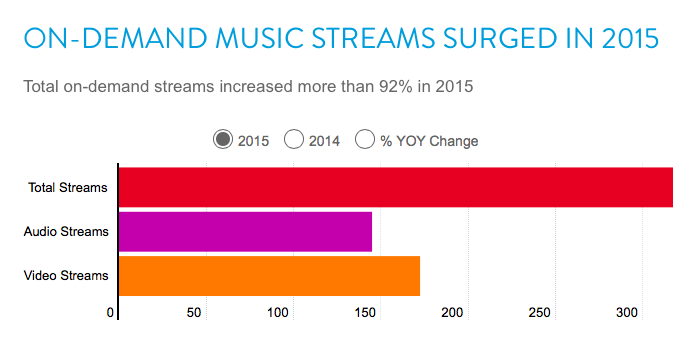Streaming data can yield important information for music directors.
A recent report by Neilson has found streaming is “riding an undeniably massive growth swell” and consumers can’t get enough.
Thus the report asks, “what if radio programmers could benefit from the surge in streaming rather than fear it?”
“When music listeners purchase or download a song, we don’t know how many times they listen to it—if at all. With streaming, we know each time a play is initiated, day after day, week after week. The data is not from a sample, a listening room or a panel. It’s an un-aided, authentic look at the songs listeners are choosing”.
Neilson’s Comparable Metrics Report suggests the information programmers can gain from streaming will allow them to stay in step with the desires of listeners.
“Streaming and radio follow each other, and following the peaks and valleys that make up listener preferences can help programmers find the next hit, determine when to stop spinning a track and assess overall playlist strength.“

How can programmers and music directors use streaming information to make judgements about programs?
One of the key learnings is to play more familiar songs more often, that’s what listeners do when they are chosing to stream their own music. Of course it’s always a delicate balancing act because, unlike on-demand streaming, we don’t know when individual listeners are listening, so we can’t target the music so precicely.
Tapping in to on-demand streaming data can also give programmers a sense of how they’re doing with respect to playing songs that aren’t new, but still have massive appeal. For example, Coldplay fans streamed “The Scientist” 928,597 times, yet the song was ranked No. 1,603 in terms of radio airplay. Comparatively, the band’s “Clocks” ranked No. 160 in terms of airplay but had only been streamed 567,312 times, highlighting about one-third less listener demand.
When we look beyond the year of release, as “Clocks” and “The Scientist” were released on A Rush of Blood to the Head in 2002, we see additional programming opportunities within the Coldplay catalog. In fact, we see that “The Scientist” and “Fix You” were the two most streamed Coldplay tracks but ranked at the bottom of the list of Coldplay tracks in radio rotation.
Following the peaks and valleys that make up listener preferences can help programmers find the next hit, determine when to stop spinning a track and assess overall playlist strength.
In an effort to illustrate the relationship, the Nielsen research analyzed the spin, sales and streaming trends for singer-rapper Bryson Tiller’s “Don’t.” While Tiller had developed quite a name for himself by the end of 2015, he got his start in the on-demand streaming space in early February. Back then, fans of the young artist were listening to an average of 30,000 streams each week, and that trend continued through early May. Between May and late June, on-demand streams averaged 400,000 per week, but the song hadn’t made it to the radio yet. Radio picked up on the swell June 29, but the number of spins was nowhere near in line with on-demand streams. In fact, the song was streamed 1.4 million times during the week the song hit 100 radio spins. By the time radio committed, fans were streaming the track 3.5 million times per week. With the additional exposure on the airwaves, on-demand streams continued climbing, eclipsing 4 million by mid-October.
Keeping an eye on streaming trends can also help programmers manage their playlists from one hit to the next. This can be particularly helpful when new artists break out with a song and programmers need to know which subsequent tracks have legs and when to start playing them.
In the case of Bryson’s “Exchange,” the follow-up to “Don’t,” the data shows how the track gained momentum in on-demand streams while “Don’t” was still hot. Despite being streamed more than 2 million times per week, “Exchange” was getting very little radio airplay. When we look at weekly data, we see that the track ranked No. 66 among streamed songs, but it was 4,043 in radio airplay rank.
In a contrasting example, consumption data shows how radio maintained the number of spins for “Stitches” by Shawn Mendes when on-demand streaming was declining.

